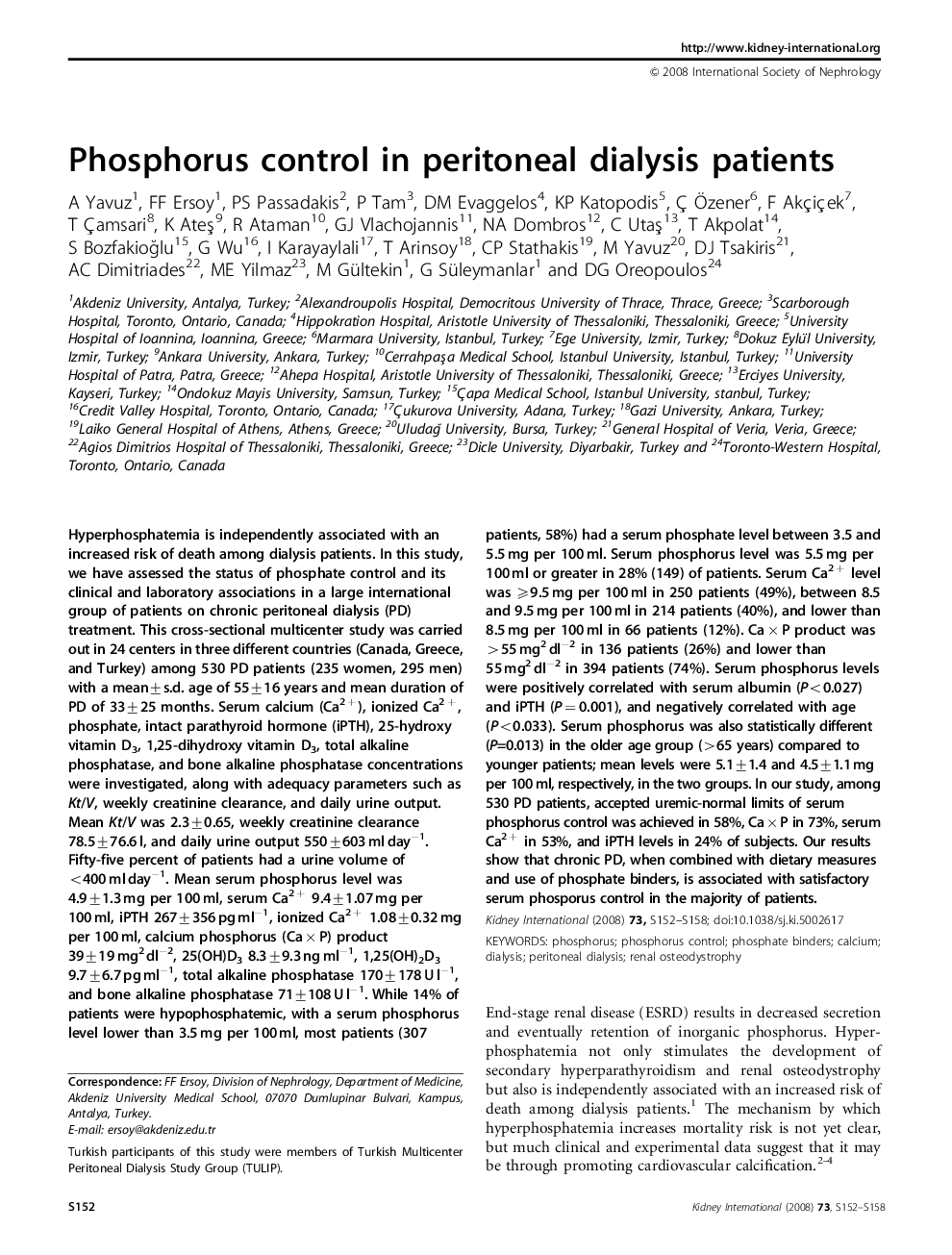| Article ID | Journal | Published Year | Pages | File Type |
|---|---|---|---|---|
| 8773536 | Kidney International | 2008 | 7 Pages |
Abstract
Hyperphosphatemia is independently associated with an increased risk of death among dialysis patients. In this study, we have assessed the status of phosphate control and its clinical and laboratory associations in a large international group of patients on chronic peritoneal dialysis (PD) treatment. This cross-sectional multicenter study was carried out in 24 centers in three different countries (Canada, Greece, and Turkey) among 530 PD patients (235 women, 295 men) with a mean±s.d. age of 55±16 years and mean duration of PD of 33±25 months. Serum calcium (Ca2+), ionized Ca2+, phosphate, intact parathyroid hormone (iPTH), 25-hydroxy vitamin D3, 1,25-dihydroxy vitamin D3, total alkaline phosphatase, and bone alkaline phosphatase concentrations were investigated, along with adequacy parameters such as Kt/V, weekly creatinine clearance, and daily urine output. Mean Kt/V was 2.3±0.65, weekly creatinine clearance 78.5±76.6âl, and daily urine output 550±603âmlâdayâ1. Fifty-five percent of patients had a urine volume of <400âmlâdayâ1. Mean serum phosphorus level was 4.9±1.3âmg per 100âml, serum Ca2+ 9.4±1.07âmg per 100âml, iPTH 267±356âpgâmlâ1, ionized Ca2+ 1.08±0.32âmg per 100âml, calcium phosphorus (Ca à P) product 39±19âmg2dlâ2, 25(OH)D3 8.3±9.3ângâmlâ1, 1,25(OH)2D3 9.7±6.7âpgâmlâ1, total alkaline phosphatase 170±178âUâlâ1, and bone alkaline phosphatase 71±108âUâlâ1. While 14% of patients were hypophosphatemic, with a serum phosphorus level lower than 3.5âmg per 100âml, most patients (307 patients, 58%) had a serum phosphate level between 3.5 and 5.5âmg per 100âml. Serum phosphorus level was 5.5âmg per 100âml or greater in 28% (149) of patients. Serum Ca2+ level was â¥9.5âmg per 100âml in 250 patients (49%), between 8.5 and 9.5âmg per 100âml in 214 patients (40%), and lower than 8.5âmg per 100âml in 66 patients (12%). Ca à P product was >55âmg2dlâ2 in 136 patients (26%) and lower than 55âmg2dlâ2 in 394 patients (74%). Serum phosphorus levels were positively correlated with serum albumin (P<0.027) and iPTH (P=0.001), and negatively correlated with age (P<0.033). Serum phosphorus was also statistically different (P = 0.013) in the older age group (>65 years) compared to younger patients; mean levels were 5.1±1.4 and 4.5±1.1âmg per 100âml, respectively, in the two groups. In our study, among 530 PD patients, accepted uremic-normal limits of serum phosphorus control was achieved in 58%, Ca à P in 73%, serum Ca2+ in 53%, and iPTH levels in 24% of subjects. Our results show that chronic PD, when combined with dietary measures and use of phosphate binders, is associated with satisfactory serum phosporus control in the majority of patients.
Keywords
Related Topics
Health Sciences
Medicine and Dentistry
Nephrology
Authors
A. Yavuz, F.F. Ersoy, P.S. Passadakis, P. Tam, D.M. Evaggelos, K.P. Katopodis, Ã Ãzener, F. Akçiçek, T. Ãamsari, K. AteÅ, R. Ataman, G.J. Vlachojannis, N.A. Dombros, C. UtaÅ, T. Akpolat, S. BozfakioÄlu, G. Wu, I. Karayaylali, D.G. Oreopoulos,
